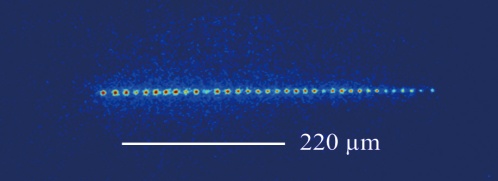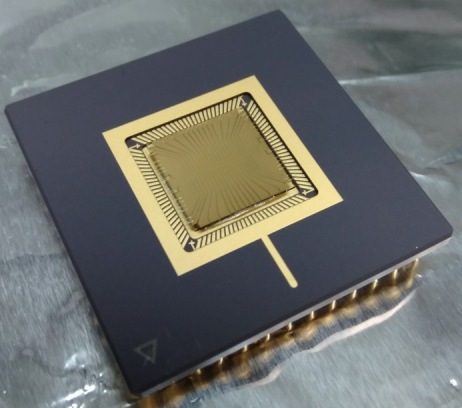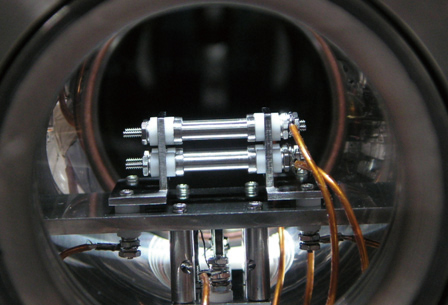Trapped-ion Optical Clock and Quantum Network
Article from NICT NEWS 2021 No. 2(Vol. 486)
Researchers: Kazuhiro HAYASAKA, Utako TANAKA
An ion trap is a device for capturing ions in a closed space with controlled magnetic fields. In combination with the laser cooling technique, it can keep ionized atoms stationary in a space. In addition, optical clocks, which are atomic clocks using optical frequencies, and quantum computers are known to be feasible by controlling the quantum states inside the atoms and of motion. This article introduces the research and development of a trapped-ion optical clock conducted by the NICT and the prospects for its application to a quantum network of optical clocks.
Background
Quantum mechanics textbooks introduce many thought experiments that involve manipulating the quantum states of each atom. However, even E. Schrödinger, one of the fathers of quantum mechanics, stated in the 1950s that experiments on an individual atom are unrealistic. However, in the late 1970s, it became possible to observe the quantum states of each ion in an ion-trap experiment. In 1982, a single-ion optical clock with a frequency accuracy of 18 digits was proposed. Then, based on the quantum state control technology of a single-ion optical clock, an ion-trap quantum computer was proposed in 1995. These technologies have translated into the recent realization of 19-digit frequency accuracy optical clocks and 32-qubit quantum computers.
Trapped-ion optical clock
The NICT has been conducting research and development on ion-trap technology since the 1990s. We have been leading the world, creating a calcium ion optical clock in 2008 and an indium ion optical clock based on sympathetic cooling in 2017. A single-ion optical clock generates an accurate optical frequency with the clock transition of an ion as the reference frequency. However, it takes a long time to determine the precise frequency due to the weak signal from a single ion. This issue was solved by an optical lattice clock that uses atomic ensembles. In this clock, ten thousand or more atoms are arranged in optical lattices, which are generated by light with a specific wavelength that cancels frequency fluctuations, to amplify the signal. Attempts have been made to use many ions in trapped-ion optical clocks, but the situation is different from a neutral atom that has no charge. In the conventional ion trap, frequency fluctuations called electric quadrupole shifts differ between ions, which leads to a different transition frequency by each ion, lowering the advantage of the use of many ions (Figure 1(a)(b)). While working to overcome this problem, the NICT has discovered a trap potential at which all ions generate the same transition frequency. Following the practice of calling the optical wavelength that suppresses the frequency fluctuations in an optical lattice clock a magic wavelength, we call this trap potential a magic potential. However, with the conventional ion trap, it is not possible to generate a magic potential due to the limited degree of freedom of controlling the potential.
On-chip ion trap
Since the conventional ion trap has the electrode arranged in three dimensions, it is not easy to generate arbitrary trap electric fields. This problem can be solved by an on-chip ion trap. In this ion trap, the electrodes approximate a flat shape and are placed on the same plane. By dividing these electrodes and applying different voltages, it is possible to generate a trap potential with a high degree of freedom (Figure 2).

Configuration of ion-trap electrode
(A) Conventional ion-trap (linear trap) and (B) On-chip ion trap
With this feature, on-chip ion traps are also widely used for quantum computers. In collaboration with Osaka University, the NICT created a prototype ion trap with 13 pairs of electrodes, and tried to generate a magic potential. As a result, we confirmed that a magic potential could be generated with 35 ions (Figure 3).

35 calcium ions trapped by the magic potential
Moreover, collaboration within the Advanced ICT Research Institute accomplished the in-house manufacturing of an on-chip ion trap with a superior surface accuracy and voltage resistance (Figure 4). In addition, we verified signal enhancement by several ions in an emulator with a conventional ion trap, and came close to creating a multi-ion optical clock using an on-chip ion trap.

On-chip trap manufactured by the NICT
Manufactured by the Frontier Research Laboratory using the NICT's in-house facility
Quantum networks with ion traps and photons
When ions generate photons, the quantum states of the ions and photons produce a correlation called “quantum entanglement.” While an ion has a mass and cannot be transported, photons can be transported over long distances in free space or through an optical fiber with relative ease. It is thought that by using ion traps and photons, we can attain quantum clock synchronization that quickly determines time by connecting optical clocks quantum-mechanically, and also create a photonically interconnected quantum computer by connecting quantum computers. The NICT has focused on quantum networks with ion traps and photons since an early stage, and, by teaming up with the Max-Planck-Institute of Quantum Optics, in 2004 succeeded in generating a single photon source with controlled time waveforms from a single ion. The wavelength of these photons was 866 nm, which limited the length of transmission through an optical fiber. However, in 2018, in collaboration with the University of Sussex and Osaka University, we demonstrated transmission through a 10-km optical fiber by converting these photons into photons having a wavelength for optical communication while preserving the quantum mechanical properties of the original photons. This achievement brought us much closer to the realization of a quantum network with ion traps connected through optical fibers.
Future prospects
Forming a network of optical clocks is expected to improve time-space information and the sensing of local gravity fluctuations, which will lead to the deployment of fiber links in Japan and other nations. A quantum network should reduce the time required for distributing and sensing time-space information obtained from such a network to the limit allowed by quantum mechanics. In addition to ion-trap technology, the NICT is conducting research and development on many element technologies required for quantum networks, such as optical frequency reference technology and micromachining technology, with the aim of pioneering the realization of these technologies.



